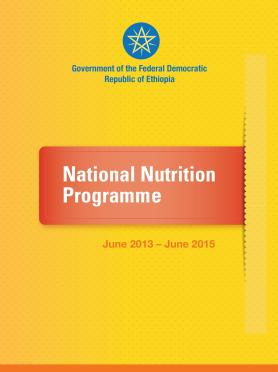ETH 2013 National Nutrition Programme
ETH 2013 National Nutrition Programme
Ethiopia, located in the northeastern part of Africa, also known as the Horn of Africa, lies between 3 and 15 degrees north latitude and 33 and 48 degrees east longitude. The total area of the country is around 1.1 million square kilometers. As of 2007, Ethiopia’s population has been growing at a rate of 2.6 percent per annum (CSA, 2007). At this rate the total population will number 88.4 million by 2015. The majority of the population (84 percent) lives in rural areas. This rapid population growth exacerbates critical gaps in basic health services, and in food and nutrition security (MOH, 2008).
The government has been implementing a comprehensive economic reform programme over the past decade. The reform programme has resulted in remarkable economic performance; macroeconomic stability was attained. A real gross domestic product (GDP) growth rate of 11 percent per annum has been achieved since 2003. The poverty level as measured by the total population under the poverty line has declined from 49.5 percent in 1994/95 to 29.2 percent in 2009/10. The food poverty head count index also declined from 38 percent to 28.2 percent between 2004/05 and 2009/10. However, poverty still affects one-third of the population (MOFED, 2010a). Ethiopia has developed a five-year development plan, the Growth and Transformation Plan (GTP), for the period 2010/11 to 2014/15. Key objectives of the GTP are ensuring high economic growth and achieving the Millennium Development Goals (MDG). Within the framework of the GTP, five-year sectoral development programmes have been outlined (MOFED, 2010b). Vital to the attainment of this plan are the systems and structures to reach communities and households.
Community based service delivery platforms have been made available in both the health and agriculture sectors to ensure decentralized and democratized public services. The Health Extension Programme (HEP) deploys two health extension workers per health post, who together reach a population of roughly 5,000. The Agricultural Extension Programme has a similar community level structure called the Agriculture Extension Programme. To strengthen and accelerate social and behavioral changes and the overall wellbeing of the population, a community level development army has been established using a “one-to- five network,” wherein out of every six households one person takes a leading role, functioning as a key link with both health and agriculture extension workers. Five such leaders comprise a development team. Each development team looks after 25 to 30 households. This arrangement is contributing to Ethiopia’s sprint toward the achievement of MDGs as we approach 2015 (MOH, 2011).

